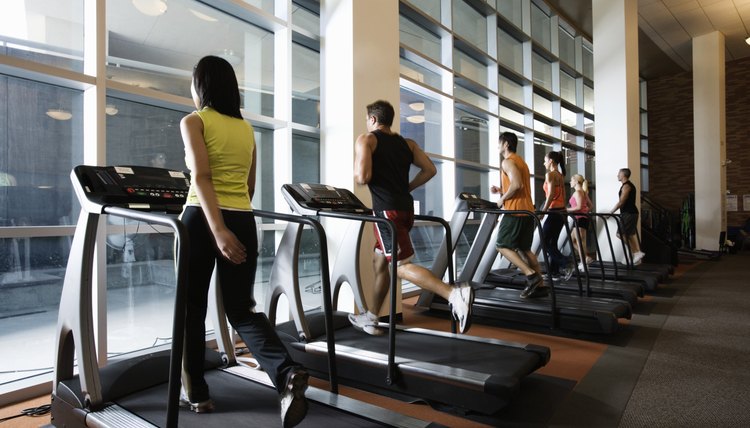Running in Place Vs. Treadmill

Treadmills and training drills such as running in place can help you achieve improvements in your running form and fitness. Although neither treadmill sessions nor running in place exactly replicate the experience of running outdoors, they do mimic - -and in some instances strengthen -- skills that support efficient running.
Benefits of a Treadmill
Treadmills are softer than asphalt, more level than grass or dirt and free of obstacles. This means you can focus entirely on form, stride rate and foot placement, all of which contribute to bio-mechanical efficiency. The Running Planet website details how most treadmills allow you to pre-program your workout with options such as hills and speed intervals, and to receive data on distance, elevation and calories burned. Motor-driven treadmills also afford you slight propulsive assistance, which may be welcome during recovery workouts.
Benefits of Running in Place
Running in place is a strenuous, plyometric action that builds lower-body strength and agility. Plyometrics, which Life Time Endurance states trains a muscle to combine maximum speed and strength, involves springing actions such as jumps and hops, and running in place is basically a sequence of alternating one-legged jumps. Specifically, it requires balance, the control of impact forces through the forefoot, and superior ankle and calf strength. Spring Track's exercise physiologist Owen Anderson describes how strong, flexible ankles and calves ensure powerful toe-offs, smooth strides and soft landings that reduce the risk of bone and ligament injury. Flexible ankles also allow full engagement of the muscles in your lower legs and feet, creating strong, elastic strides and delaying fatigue.
Running in Place Technique
Begin leaping softly from foot to foot for five minutes, focusing on landing on the balls of your feet and kicking your heels toward the ceiling. Gradually increase your tempo and height, and try to hit your butt with your heels. This explosive, all-leg action generates quick muscle contraction and relaxation, training your neuromusculature for speed work and racing. Exercise Goals illustrates a variation: the high-knee drill. Instead of heel-kicking your glutes you're bringing your knees up high in front of you. This strengthens your hip and abdominal muscles.
Treadmill Technique
When striding forward, concentrate on placing each foot directly under your body when it hits the belt. According to Sports Injury Bulletin's notes on biomechanics, landing over your foot decreases any braking action from your heels and encourages your hamstrings to immediately pull your limb back, generating forward propulsion. Forcefully extend your leg behind you and as level to the ground as possible by contracting your hamstrings and "flicking" your ankles. This minimizes vertical movement -- the opposite of running in place.
Dealing With Impact Forces
When you run in place, your feet generate significant vertical energy, while on the treadmill your feet generate more forward momentum, and your workout is generally less jarring. However, higher impact forces lead to quicker muscle adaptation and greater muscle strength. So, mix it up; both types of workout can help you become a better athlete.
Writer Bio
Based in New York City, Fiona Bayly writes about running with a focus on health, nutrition and training strategies for athletes from beginner to professional. She is an avid triathlete, former New England Scholastic Cross Country champion and current member of TeamUSA's age-group championship team in the sport of Aquathlon.
